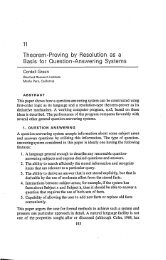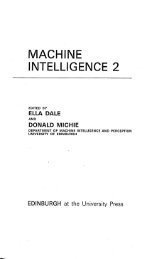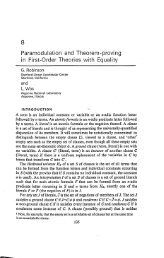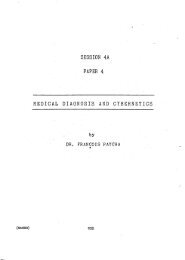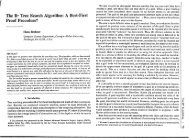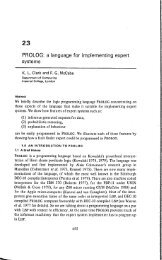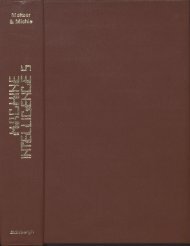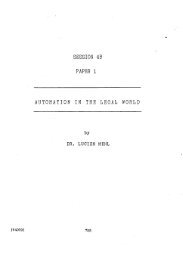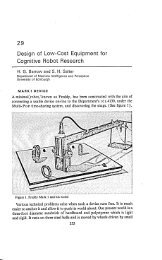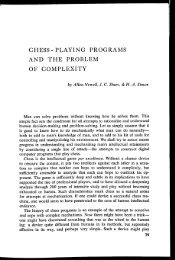PUFF: An Expert System for Interpretation of Pulmonary ... - AITopics
PUFF: An Expert System for Interpretation of Pulmonary ... - AITopics
PUFF: An Expert System for Interpretation of Pulmonary ... - AITopics
- No tags were found...
You also want an ePaper? Increase the reach of your titles
YUMPU automatically turns print PDFs into web optimized ePapers that Google loves.
19<strong>PUFF</strong>: <strong>An</strong> <strong>Expert</strong> <strong>System</strong><strong>for</strong> <strong>Interpretation</strong> <strong>of</strong><strong>Pulmonary</strong> Function DataJanice S. Aikins, John C. Kunz,Edward H. Shortliffe, and Rohert J. FallatI n this and the next chapter we close this volume with discussions <strong>of</strong> thetwo AIM systems that had achieved routine use by the end <strong>of</strong> thpfirst decade<strong>of</strong> research in the field. It is irnportant to note that neither requires directinteraction with a physician requesting advice. Thus both systems avoid thesign~ficant problems <strong>of</strong> human engineering and user acceptance that definemany <strong>of</strong> the serious research problems that remain unsolved at present [seeTeach and Shortliffe (1981) and a further discussion <strong>of</strong> these points inChapter 21]. H owe'ver, each does provide a glimjJse <strong>of</strong> what lies ahead,and their success at d~nicult tasks is an encouraging indication <strong>of</strong> thepractical impact that we can eventually expect from this kind <strong>of</strong> work.Because MYCIN was designed to Iteep its knowledge base <strong>of</strong> rules separatefrom the program that used them to generate advice (Chapter 5), itwas recognized that the program itself could be isolated and used in otherdomains <strong>for</strong> which additional rule sets were developed. The resulting EMYCIN system (van Melle, 1980) was used to build several other programsduring the late 1970s, in both medical and nonmedical donzains [e.g.,SACON, a program to provide guidance regarding the use <strong>of</strong> a computersystem to aid in aircraft design (Bennett and Englemore, 1979)]. <strong>An</strong> earlysystem developed using EMYCIN was <strong>PUFF</strong>, a collaborative ef<strong>for</strong>t betweencomputer scientists from Stan<strong>for</strong>d Universi(y, researchers from the Institutp<strong>of</strong> Medical Sciences in San Francisco, and physicians from Pacific MedicalCenter (PMC).From Computers ill Biollledim/ Researr/z, Hi: J99-20H (1983), Copyright © 1983 by AcademicPress, Inc. All rights reserved. Used with permission.444
448 <strong>PUFF</strong>: <strong>An</strong> <strong>Expert</strong> <strong>System</strong> <strong>for</strong> <strong>Interpretation</strong> <strong>of</strong> <strong>Pulmonary</strong> Function Data4. PF data interpretation was a problem that was large enough to be interesting(the biomedical researchers did not know how to solve it, andthe AI researchers did not know whether their techniques would beappropriate) and small enough that a pilot project <strong>of</strong> several months'duration could concretely demonstrate the feasibility <strong>of</strong> a longer developmentef<strong>for</strong>t. Furthermore, the amount <strong>of</strong> domain-specific knowledgeinvolved in pulmonary function testing is limited enough to makeit feasible to acquire, understand, and represent that knowledge.5. The domain <strong>of</strong> pulmonary physiology is a circumscribed field: the dataneeded to interpret patient status are available from the patient's historyand from measurements taken in a single laboratory. Other large bodies<strong>of</strong> knowledge are not required in order to produce accurate diagnoses<strong>of</strong> pulmonary disease in the patient. 26. All the data used in the laboratory at PMC were already available in acomputer; the computer data were known to be accurate, reliable, andrelevant to the interpretation task. The clinical staff in the PF lab werealready receptive to the use <strong>of</strong> computers within their clinical routines.7. <strong>Pulmonary</strong> physiologists who interpret test measurements tend tophrase their interpretations similarly from one case to the next. Onegoal <strong>of</strong> <strong>PUFF</strong> was to generate reports from a set <strong>of</strong> prototypical interpretationstatements, thus saving the staff a great deal <strong>of</strong> tedious work.The staff themselves would not be displaced by this tool because theirexpertise still would be necessary to verify <strong>PUFF</strong>'s output, to handleunexpectedly complex cases, and to correct interpretations that theyfelt were inaccurate.19.4 Project History and StatusThis research developed from work done on the MYCIN system (Chapter5). That program used a knowledge base <strong>of</strong> production rules (Davis andKing, 1977) to per<strong>for</strong>m -infectious disease consultations. <strong>PUFF</strong> was initiallybuilt using a generalization <strong>of</strong> the MYCIN system called EMYCIN (vanMelle, 1979). EMYCIN, or "Essential MYCIN ," consists <strong>of</strong> the domainindependentfeatu~es <strong>of</strong> MYCIN, principally the rule interpreter, explanation,and knowledge-acquisition modules (Shortliffe et aI., 1975). It providesa mechanism <strong>for</strong> representing domain-specific knowledge in the <strong>for</strong>m<strong>of</strong> production rules, and <strong>for</strong> per<strong>for</strong>ming consultations in that domain. Justas MYCIN consists <strong>of</strong> EMYCIN plus a set <strong>of</strong> facts and rules about diagnosisand therapy <strong>of</strong> infectious diseases, <strong>PUFF</strong> consists <strong>of</strong> the EMYCIN programsplus a pulmonary disease knowledge base.2This was a problem in MYCIN, a related system <strong>for</strong> determining the diagnosis and therapy<strong>for</strong> infectious disease cases. The results produced by the system <strong>of</strong>ten suffered because itlacked knowledge about related diseases that were also present in the patient.
Overview <strong>of</strong> EMYCIN-<strong>PUFF</strong> 451typical case. The medical knowledge in <strong>PUFF</strong> is encoded as rules. Rulesencode relatively small and independent bodies <strong>of</strong> domain knowledge. Therule <strong>for</strong>malism makes modification <strong>of</strong> the program's knowlecg-e much easierthan when that knowledge is embedded in computer code. However,additions or modifications to the rules as referred to in the second pointhave caused difficulties because changes to one rule sometimes affect thebehavior <strong>of</strong> other rules in unanticipated ways. The last two points applyonly to the EMYCIN version <strong>of</strong> <strong>PUFF</strong>, which runs interactively in a consultation-style,question-and-answer mode with the user. In that system,questions are sometimes asked in an unusual order, and explanations <strong>of</strong>both the questions being asked <strong>of</strong> the user and the final interpretationneed to be improved.Even though <strong>PUFF</strong> does exhibit certain limitations, the representation<strong>of</strong> pulmonary knowledge as production rules allows the encoding <strong>of</strong> interpretiveexpertise that previously was difficult to define because it is heuristicknowledge <strong>of</strong> the expert. EMYCIN on the SUMEX computer providedan excellent environment <strong>for</strong> acquiring, encoding, and debuggingthis expertise. However, it would have been inefficient and somewhat impracticalto use the interactive EMYCIN version <strong>of</strong> <strong>PUFF</strong> in a hospitalsetting. The simplicity <strong>of</strong> EMYCIN's reasoning process made the translationinto BASIC procedures a feasible task, thus allowing the hospital's owncomputer staff to take over maintenance <strong>of</strong> the system.The BASIC version <strong>of</strong> <strong>PUFF</strong> runs in batch mode and does not requireinteraction with a physician. We believe that this system was readily acceptedby the pulmonary staff <strong>for</strong> several reasons. First, the program'sinterpretations are consistently accurate. Second, explanations <strong>of</strong> diagnosesare appropriately detailed so that the user has confidence in the accuracy<strong>of</strong> correct diagnoses and enough in<strong>for</strong>mation with which to recognize andmodify incorrect diagnoses. Third, less physician time is required to produceconsistently high-quality reports using the system than is required toanalyze and dictate case reports without it. Finally, the program is wellintegrated into the routine <strong>of</strong> the laboratory; its use requires very littleextra technician ef<strong>for</strong>t.19 • 6Overview <strong>of</strong> EMYCIN-<strong>PUFF</strong>19.6.1 Knowledge RepresentationThe knowledge base <strong>of</strong> the EMYCIN-<strong>PUFF</strong> system consists <strong>of</strong> (a) a set <strong>of</strong>64 production rules dealing with the interpretation <strong>of</strong> pulmonary functiontests and (b) a set <strong>of</strong> 59 clinical parameters. The production version (BASIC<strong>PUFF</strong>) has been extended to include 400 production rules and 75 clinicalparameters. The clinical parameters represent pulmonary function testresults (e.g., TOTAL LUNG CAPACITY and RESIDUAL VOLUME), pa-
452 <strong>PUFF</strong>: <strong>An</strong> <strong>Expert</strong> <strong>System</strong> <strong>for</strong> <strong>Interpretation</strong> <strong>of</strong> <strong>Pulmonary</strong> Function DataRULE011IF: 1) A: The mmf/mmf-predicted ratio is between 35 and 45, andB: The fvc/fvc-predicted ratio is greater than 80, or2) A: The mmf/mmf-predicted ratio is between 25 and 35, andB: The fvc/fvc-predicted ratio is less than 80THEN: 1) There is suggestive evidence (.5) that the degree <strong>of</strong>obstructive airways disease as indicated by the MMFis moderate, and2) It is definite (1.0) that the following is one <strong>of</strong> thefindings about the diagnosis <strong>of</strong> obstructive airwaysdisease: Reduced mid-expiratory flow indicatesmoderate airway obstruction.PREMISE: [$AND ($OR ($AND (BETWEEN' (VAL1 CNTXT MMF) 35 45)(GREATER' (VAL 1 CNTXT FVC) 80))($AND (BETWEEN' (VAL 1 CNTXT MMF) 25 35)(LESSP* (VAL 1 CNTXT FVC) 80)ACTION: (DO-ALL (CONCLUDE CNTXT DEG-MMF MODERATE TALLY 500)(CONCLUDETEXT CNTXT FINDINGS-OAD(TEXT $MMF/FVC2) TALLY 1000))FIGURE 19-3versions.A <strong>PUFF</strong> production rule in English and LISPtient data (e.g., AGE and REFERRAL DIAGNOSIS), and data that arederived from the rules (e.g., FINDINGS associated with a disease andSUBTYPES associated with the disease). There may be auxiliary in<strong>for</strong>mationassociated with the clinical parameters, such as a list <strong>of</strong> expectedvalues and an English translation used in communicating with the user.The production rules operate on associative triples, where the attributes are the clinical parameters, the object is thepatient, and the values are given by the patient data and lung test results.Questions are asked during the consultation in an attempt to fill in values<strong>for</strong> the parameters.The production rules consist <strong>of</strong> one or mote premise clauses followedby one or more action clauses. Each premise is a conjunction <strong>of</strong> predicatesoperating on associative triples in the knowledge base. A sample <strong>PUFF</strong>production rule is shown in Figure 19-3.The rules are coded internally in LISP. The user <strong>of</strong> the system seesthe production rules in their English <strong>for</strong>m, which is shown in the upperpart <strong>of</strong> the figure. The English version is generated automatically fromtemplates, as is described in van Melle (1979).19.6.2 Control StructureThe EMYCIN-<strong>PUFF</strong> control structure is primarily a goal-directed backwardchaining <strong>of</strong> production rules. The goal <strong>of</strong> the system at any time isto determine a value <strong>for</strong> a given clinical parameter. 'ICJ conclude a value
Evaluation <strong>of</strong> the BASIC-<strong>PUFF</strong> Per<strong>for</strong>mance <strong>System</strong> 453<strong>for</strong> a clinical parameter, the program tries a precomputed list <strong>of</strong> ruleswhose actions conclude values <strong>for</strong> the clinical parameter [refer to van Melle(1979) <strong>for</strong> details].If the rules fail to conclude a value <strong>for</strong> a parameter, a question is thenasked <strong>of</strong> the user in order to obtain that value. <strong>An</strong> exception to this processoccurs <strong>for</strong> parameters labeled ASKFIRST. These represent in<strong>for</strong>mationgenerally known by the user, such as results <strong>of</strong> pulmonary function tests.For these parameters it is more efficient simply to ask a consultation questionthan to attempt to infer the in<strong>for</strong>mation by means <strong>of</strong> rules. 419.7Evaluation <strong>of</strong> the BASIC-<strong>PUFF</strong> Per<strong>for</strong>mance<strong>System</strong>The knowledge base from the original per<strong>for</strong>mance version <strong>of</strong> <strong>PUFF</strong> wastested on 107 cases chosen from files in the pulmonary function laboratoryat Pacific Medical Center. Those 107 cases <strong>for</strong>med a representative sample<strong>of</strong> the various pulmonary diseases, their degrees, and their subtypes. Modificationswere made to the knowledge base, and the cases were tried again.This iteration continued until our collaborating expert was satisfied thatthe system's interpretations agreed with his own. At this point the systemwas "frozen," and a new set <strong>of</strong> 144 cases was selected and interpreted bythe system. All 144 cases also were interpreted separately by two pulmonaryphysiologists (the expert working with us and a physician from adifferent medical center).The results <strong>of</strong> the comparison <strong>of</strong> interpretations by each diagnosticianare presented in the table in Figure 19-4. The table com pares close agreementin diagnosing the severity <strong>of</strong> the disease, where close is defined asdiffering by at most 1 degree <strong>of</strong> severity. Thus, <strong>for</strong> example, diagnoses <strong>of</strong>mild (degree = 1) and moderate (degree = 2) are considered close, whilemild and severe (degree = 3) are not. Further, a diagnosis <strong>of</strong>'normal isnot considered to be close to a diagnosis <strong>of</strong> a mild degree <strong>of</strong> any disease.The table shows that the overall rate <strong>of</strong> agreement between the twophysiologists on the diagnoses <strong>of</strong> disease was 92%. The agreement between<strong>PUFF</strong> and the physician who served as the expert to develop the <strong>PUFF</strong>knowledge base (MD-l in the table) was 96%. Finally, the agreement between<strong>PUFF</strong> and the physician who had no part in the development <strong>of</strong> the<strong>PUFF</strong> knowledge base (MD-2) was 89%. Figure 19-5 shows the distribution<strong>of</strong> diagnoses by each diagnostician. The number <strong>of</strong> diagnoses made byeach diagnostician does not total 144 because patients were <strong>of</strong>ten diagnosedas having more than one disease.lIn the BASIC version <strong>of</strong> <strong>PUFF</strong> implemented at PMC, all <strong>of</strong> the test data are known ahead<strong>of</strong> time so that "asking a question" merely entails retrie\'ing another datum from a storedfile.
454 <strong>PUFF</strong>: <strong>An</strong> <strong>Expert</strong> <strong>System</strong> <strong>for</strong> <strong>Interpretation</strong> <strong>of</strong> <strong>Pulmonary</strong> Function DataPERCENT AGREEMENTMD-1 MD-lDIAGNOSIS MD-2 <strong>PUFF</strong>MD-2<strong>PUFF</strong>NORr .. 1ALOADRLDDD92 9594 9992 9990 9192948585TOTAL(S.D.)92 96(1.(3) (3.83)89(4.6~)Diseases:Normal = "!ormal <strong>Pulmonary</strong> FunctionOAO =: Ob::,trucUvc ,l\irways DiseaseRLD:-;; RestrictivC) L.ung DiseaseDO:=: Difiusion DefectFIGURE 19-4 Summary <strong>of</strong> percent agreement in 144 cases.DIAGNOSTICIANDIAGNOSIS MD-1 MO-2 <strong>PUFF</strong>NORMAL 31 26 30OAD 79 85 89RLD 52 45 55DD 53 35 52FIGURE 19-5144 cases.Number <strong>of</strong> diagnoses by each diagnostician <strong>for</strong>
Conclusions 45519 8 Conclusions•The <strong>PUFF</strong> research has demonstrated that if the task, domain, and researchersare carefully matched, then the application <strong>of</strong> existing techniquescan result in a system that successfully per<strong>for</strong>ms a moderately complicatedtask <strong>of</strong> medical diagnosis. Success <strong>of</strong> the program can be measured notonly in terms <strong>of</strong> the system's technical per<strong>for</strong>mance, but equally importantly,by the ease and practicality <strong>of</strong> the system's day-to-day use in the lab<strong>for</strong> which it was designed. Rule-based representation allowed easy codificationand later modification <strong>of</strong> expertise. The simplicity <strong>of</strong> the rule interpreterin the Interlisp version facilitated translation into BASIC and implementationon the hospital's own PDP-II machine. Using EMYCINallowed the researchers to move quickly from a point where they found itdifficult even to describe the diagnostic process to a point where a simplediagnostic model was implemented. Having a diagnostic model allowedthem to focus on individual issues in order to improve that model. Although<strong>PUFF</strong> does not itself represent new artificial intelligence techniques,its success is a testimonial <strong>for</strong> EMYCIN. In addition, its simplicityhas facilitated careful analysis <strong>of</strong> EMYCIN's rule representation and controlstructure and has led to other productive research ef<strong>for</strong>ts (Aikins,1980; 1983; Smith and Clayton, 1980).ACKNOWLEDGMENTSThe <strong>PUFF</strong> research team consists <strong>of</strong> an interdisciplinary group <strong>of</strong> physiciansand computer scientists. In addition to the authors, these have includedLarry Fagan, Ed Feigenbaum, Penny Nii, Dr. John Osborn, Dr. B.J. Rubin, and Dianne Sierra. We also thank Dr. B. A. Votteri <strong>for</strong> his helpin evaluating <strong>PUFF</strong>'s per<strong>for</strong>mance and Doug Aikins <strong>for</strong> his editorial helpwith this paper.The research was funded in part by NIH grants MB-OO 134 and GM-24669. Computer facilities were provided by the SUMEX-AIM facility atStan<strong>for</strong>d University under NIH grant RR-00785. Dr. Shortliffe is supportedby research career development award LM-00048 from the NationalLibrary <strong>of</strong> Medicine. Dr. Aikins was supported by the Xerox Corporationunder the direction <strong>of</strong> the Xerox Palo Alto Research Center.



